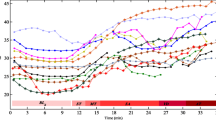Abstract
Ballistocardiography (BCG) is a non-invasive technique used to measure the ejection force of blood into the aorta which can be used to estimate cardiac output and contractility change. In this work, a noise sensor was embedded in a BCG measurement system to detect excessive motion from standing subjects. For nine healthy subjects, the cross-correlation of the motion signal to the BCG noise—estimated using a simultaneously acquired electrocardiogram and statistics of the BCG signal—was found to be 0.94 and 0.87, during periods of standing still and with induced motion artifacts, respectively. In a separate study, where 35 recordings were taken from seven subjects, a threshold-based algorithm was used to flag motion-corrupted segments of the BCG signal using only the auxiliary motion sensor. Removing these flagged segments enhanced the BCG signal-to-noise ratio (SNR) by an average of 14 dB (P < 0.001). This integrated motion-sensing technique addresses a gap in methods available to identify and remove noise in standing BCG recordings due to movement, in a practical manner that does not require user intervention or obtrusive sensing.




Similar content being viewed by others
References
Alihanka J, Vaahtoranta K, Saarikivi I (1981) A new method for long-term monitoring of the ballistocardiogram, heart rate, and respiration. Am J Physiol 240:R384
Chaudhry SI, Wang Y, Concato J, Gill TM, Krumholz HM (2007) Patterns of weight change preceding hospitalization for heart failure. Circulation 116:1549–1554
Dubin D (2000) Rapid interpretation of EKG’s, 6th edn. Cover Publishing Co., Tampa, FL
Etemadi M, Inan OT, Wiard RM, Kovacs GTA, Giovangrandi L (2009) Non-invasive assessment of cardiac contractility on a weighing scale. In: 31st annual IEEE engineers in medicine and biology conference. IEEE, Minneapolis, MN
Gage WH, Winter DA, Frank JS, Adkin AL (2004) Kinematic and kinetic validity of the inverted pendulum model in quiet standing. Gait Posture 19:124–132
Inan OT, Etemadi M, Paloma A, Giovangrandi L, Kovacs GTA (2009) Non-invasive cardiac output trending during exercise recovery on a bathroom-scale-based ballistocardiograph. Physiol Meas 30:261–274
Inan OT, Etemadi M, Wiard RM, Giovangrandi L, Kovacs GTA (2009) Robust ballistocardiogram acquisition for home monitoring. IOP J Physiol Meas 30:169–185
Inan OT, Etemadi M, Wiard RM, Kovacs GTA, Giovangrandi L (2009) Novel methods for estimating the ballistocardiogram signal using a simultaneously acquired electrocardiogram. In: 31st annual IEEE engineers in medicine and biology conference. IEEE, Minneapolis, MN
Inan OT, Kovacs GTA, Giovangrandi L (2010) Evaluating the lower-body electromyogram signal acquired from the feet as a noise reference for standing ballistocardiogram measurements. IEEE Trans Inf Technol Biomed 14:1188–1196
Ishijima M (2007) Unobtrusive approaches to monitoring vital signs at home. Med Biol Eng Comput 45(11):1137–1141
Masoudi FA, Havranek EP, Krumholz HM (2002) The burden of chronic congestive heart failure in older persons: magnitude and implications for policy and research. Heart Fail Rev 7:9–16
Piccini JP, Hranitzky P (2007) Diagnostic monitoring strategies in heart failure management. Am Heart J 153:12–17
Rappaport MB, Sprague HB, Thompson WB (1953) Ballistocardiography: I. Physical considerations. Circulation 7:229–246
Rosamond W, Flegal K, Furie K, Go A, Greenlund K, Haase N, Hailpern SM, Ho M, Howard V, Kissela B, Kittner S, Lloyd-Jones D, McDermott M, Meigs J, Moy C, Nichol G, O’Donnell C, Roger V, Sorlie P, Steinberger J, Thom T, Wilson M, Hong Y (2008) Heart disease and stroke statistics—2008 update: a report from the American Heart Association Statistics Committee and Stroke Statistics Subcommittee. Circulation 117:e25–e146
Starr I, Rawson AJ, Schroeder HA, Joseph NR (1939) Studies on the estimation of cardiac output in man, and of abnormalities in cardiac function, from the heart’s recoil and the blood’s impacts; the ballistocardiogram. Am J Physiol 127:1–28
Wiard RM, Kim HJ, Figueroa CA, Kovacs GTA, Taylor CA, Giovangrandi L (2009) Estimation of central aortic forces in the ballistocardiogram under rest and exercise conditions. In: 31st annual IEEE engineers in medicine and biology conference, Minneapolis, MN
Winter DA, Patla AE, Prince F, Ishac M, Gielo-Perczak K (1998) Stiffness control of balance in quiet standing. J Neurophysiol 80:1211–1221
Author information
Authors and Affiliations
Corresponding author
Rights and permissions
About this article
Cite this article
Wiard, R.M., Inan, O.T., Argyres, B. et al. Automatic detection of motion artifacts in the ballistocardiogram measured on a modified bathroom scale. Med Biol Eng Comput 49, 213–220 (2011). https://doi.org/10.1007/s11517-010-0722-y
Received:
Accepted:
Published:
Issue Date:
DOI: https://doi.org/10.1007/s11517-010-0722-y




